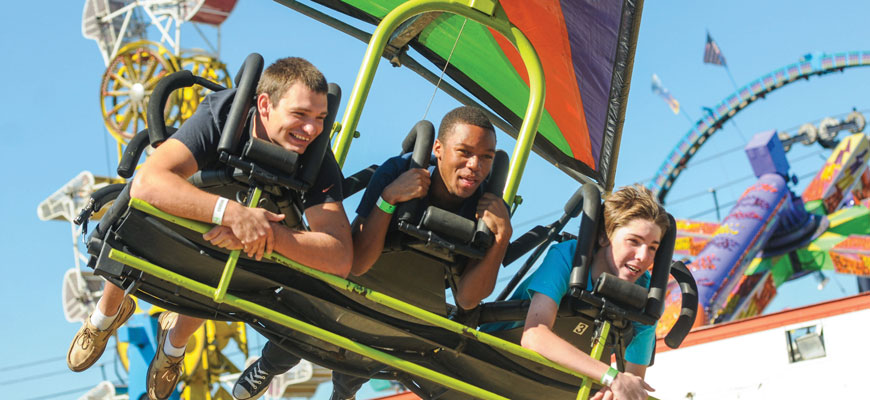
French fries, Ferris wheels ... and physics
Physics day at the fair brings together UofSC faculty, high school students
Posted on: October 11, 2017; Updated on: October 11, 2017
By Megan Sexton, msexton@mailbox.sc.edu, 803-777-1421
It’s not all corn dogs, blue ribbons and roller coasters at the South Carolina State Fair. There’s some science education going on, too.
For the 21st year, faculty and students at the University of South Carolina will spend a day at the fair with 2,500 high school students from every corner of the state, helping them understand more about physics – while learning to be better teachers themselves.
Dave Tedeschi, a professor of physics and astronomy in the College of Arts and Sciences, says the confluence of fun, science and teaching is what draws him back each year to the R.L. Childers Midway Physics Day, named for a long-time Carolina physics professor.
Tedeschi will join other physics professors and graduate students on Oct. 17 to serve as guides for high schoolers in the physics tent and on the Midway. He may, for example, ask a graduate student to explain why, if you’re twirling on a platform, you spin faster if you pull your hands close to your body, and slower if you stretch out your arms.
“I tell our graduate students, ‘Can you explain that to someone with no physics knowledge? Go.’ And at first, they can’t,” Tedeschi says. “It’s not because they’re unable, but they’ve never been trained for that. This is a perfect opportunity, a laboratory. This is the out-of-the-classroom training that the university wants to formalize in many ways.
This gives us a megaphone for the day and allows us to give back to the community and talk about science. I love the fair.
Dave Tedeschi, professor of physics and astronomy
“We give them a little taste of that so they understand teaching takes time and effort. They need to think about, ‘How do I communicate something to someone who doesn’t have the same tools as I do at the moment?’ That’s a teaching exercise, and that’s one of the things I really love about the day.”
Once the rides open, the high schoolers flee the tent for their first taste of physics fieldwork – aboard the Mega Drop or the Bullet Train roller coaster – measuring and thinking critically about topics like conservation of energy. While the early physics at the fair days featured measurement gadgets and home-made instruments, now data can be captured with a cell phone. Yet students soon learn that experiments done in the field don’t mimic the controlled atmosphere of a classroom lab.
“You get out and the sun is too bright, and you can’t read your computer screen, or you run out of batteries. Who knows what’s going to happen in the field? Science is not always perfect like in a textbook; in fact, it usually isn't,” Tedeschi says. “To get out of the classroom is great. This is a first taste of field work for the high school students. But it should be fun. They should have curly fries and ride the rides to go with the hard work.”
For Carolina professors, the connection made with high school teachers is key, and the work begins early, with USC hosting workshops for teachers in the weeks leading up to the fair.
“If we affect the teacher who becomes a better teacher or who can have those couple of units of science be more effective because of the way we help, then our reach is broader or deeper,” Tedeschi says. “Sometimes people think physics is complicated or boring, but in fact it’s exciting and interesting. And this gives us a megaphone for the day and allows us to give back to the community and talk about science. I love the fair. And this is a wonderful marriage of being in that atmosphere and combining it with teaching. Why would I not go?”